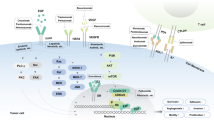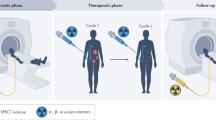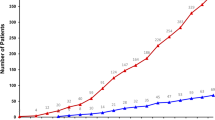Abstract
Targeted treatment has substantially changed the field of oncology. Compared with cytotoxic chemotherapy, many novel targeted therapies are administered over long periods of time, and result in disease stabilization rather than tumor shrinkage. The activity of these novel agents might, therefore, be better reflected by changes in molecular features of the tumor rather than reduction in size or volume. Thus, noninvasive procedures to measure such features are urgently needed. Factors that need to be predicted are early response (silencing of tumor signaling) or resistance to therapy, and whether therapy can be interrupted. Molecular imaging techniques, such as PET, may provide clinically relevant information; however, data are so far available mainly from small, observational, retrospective studies. Findings need to be further assessed in clinical trials to assess whether molecular imaging can be exploited and widely introduced to aid daily practice in oncology.
This is a preview of subscription content, access via your institution
Access options
Subscribe to this journal
Receive 12 print issues and online access
$209.00 per year
only $17.42 per issue
Buy this article
- Purchase on Springer Link
- Instant access to full article PDF
Prices may be subject to local taxes which are calculated during checkout
Similar content being viewed by others
References
Desar, I. M. et al. The reverse side of the victory: Flare up of symptoms after discontinuation of sunitinib or sorafenib in renal cell cancer patients. A report of three cases. Acta Oncol. 19, 1–4 (2009).
Blay, J. Y. et al. Prospective multicentric randomized phase III study of imatinib in patients with advanced gastrointestinal stromal tumors comparing interruption versus continuation of treatment beyond 1 year: the French Sarcoma Group. J. Clin. Oncol. 25, 1107–1113 (2007).
Wardelmann, E. et al. Acquired resistance to imatinib in gastrointestinal stromal tumours caused by multiple KIT mutations. Lancet Oncol. 6, 249–251 (2005).
Desar, I. M. et al. Beyond RECIST: molecular and functional imaging techniques for evaluation of response to targeted therapy. Cancer Treat. Rev. 35, 309–321 (2009).
Pieterman, R. M. et al. Preoperative staging of non-small-cell lung cancer with positron-emission tomography. N. Engl. J. Med. 343, 254–261 (2000).
Vansteenkiste, J., Fisher, B. M., Dooms, C. & Mortensen, J. Positron-emission tomography in prognostic and therapeutic assessment of lung cancer: systematic review. Lancet Oncol. 5, 531–540 (2004).
de Geus-Oei, L. F. et al. FDG-PET for prediction of survival of patients with metastatic colorectal carcinoma. Ann. Oncol. 17, 1650–1655 (2006).
Emmering, J. et al. Preoperative [18F] FDG-PET after chemotherapy in locally advanced breast cancer: prognostic value as compared with histopathology. Ann. Oncol. 19, 1573–1577 (2008).
Cachin, F., Prince, H. M., Hogg, A., Ware, R. E. & Hicks, R. J. Powerful prognostic stratification by [18F]fluorodeoxyglucose positron emission tomography in patients with metastatic breast cancer treated with high-dose chemotherapy. J. Clin. Oncol. 24, 3026–3031 (2006).
Kidd, E. A., Siegel, B. A., Dehdashti, F. & Grigsby, P. W. The standardized uptake value for F-18 fluorodeoxyglucose is a sensitive predictive biomarker for cervical cancer treatment response and survival. Cancer 110, 1738–1744 (2007).
Connell, C. A. et al. Clinical impact of, and prognostic stratification by, F-18 FDG PET/CT in head and neck mucosal squamous cell carcinoma. Head Neck 29, 986–995 (2007).
Guo, H. et al. Diagnostic and prognostic value of 18F-FDG PET/CT for patients with suspected recurrence from squamous cell carcinoma of the esophagus. J. Nucl. Med. 48, 1251–1258 (2007).
Weber, W. A. et al. Prediction of response to preoperative chemotherapy in adenocarcinomas of the esophagogastric junction by metabolic imaging. J. Clin. Oncol. 19, 3058–3065 (2001).
Ott, K. et al. Metabolic imaging predicts response, survival, and recurrence in adenocarcinomas of the esophagogastric junction. J. Clin. Oncol. 24, 4692–4698 (2006).
Lordick, F. et al. PET to assess early metabolic response and to guide treatment of adenocarcinoma of the oesophagogastric junction: the MUNICON phase II trial. Lancet Oncol. 8, 797–805 (2007).
Van den Abbeele, A. D. The lessons of GIST—PET and PET/CT: a new paradigm for imaging. Oncologist 13 (Suppl. 2), 8–13 (2008).
Prior, J. O. et al. Early prediction of response to sunitinib after imatinib failure by 18F-fluorodeoxyglucose positron emission tomography in patients with gastrointestinal stromal tumor. J. Clin. Oncol. 27, 439–445 (2009).
Emanuel, E. J. & Fuchs, V. R. The perfect storm of overutilization. JAMA 299, 2789–2791 (2008).
Troost, E. G. et al. 18F-FLT PET does not discriminate between reactive and metastatic lymph nodes in primary head and neck cancer patients. J. Nucl. Med. 48, 726–735 (2007).
Chen, W. et al. Imaging proliferation in brain tumors with 18F-FLT PET: comparison with 18F-FDG. J. Nucl. Med. 46, 945–952 (2005).
Pio, B. S. et al. Usefulness of 3'-[F-18]fluoro-3'-deoxythymidine with positron emission tomography in predicting breast cancer response to therapy. Mol. Imaging Biol. 8, 36–42 (2006).
Perik, P. J. et al. Indium-111-labeled trastuzumab scintigraphy in patients with human epidermal growth factor receptor 2-positive metastatic breast cancer. J. Clin. Oncol. 24, 2276–2282 (2006).
de Korte, M. A. et al. 111Indium-trastuzumab visualises myocardial human epidermal growth factor receptor 2 expression shortly after anthracycline treatment but not during heart failure: a clue to uncover the mechanisms of trastuzumab-related cardiotoxicity. Eur. J. Cancer 43, 2046–2051 (2007).
Beer, A. J. et al. Comparison of integrin αVβ3 expression and glucose metabolism in primary and metastatic lesions in cancer patients: a PET study using 18F-galacto-RGD and 18F-FDG. J. Nucl. Med. 49, 22–29 (2008).
Scheer, M. G. et al. Imaging liver metastases of colorectal cancer patients with radiolabelled bevacizumab: lack of correlation with VEGF-A expression. Eur. J. Cancer 44, 1835–1840 (2008).
Author information
Authors and Affiliations
Corresponding author
Ethics declarations
Competing interests
The authors declare no competing financial interests.
Rights and permissions
About this article
Cite this article
Oyen, W., van der Graaf, W. Molecular imaging of solid tumors: exploiting the potential. Nat Rev Clin Oncol 6, 609–611 (2009). https://doi.org/10.1038/nrclinonc.2009.139
Issue Date:
DOI: https://doi.org/10.1038/nrclinonc.2009.139
This article is cited by
-
PET–CT for radiotherapy treatment planning and response monitoring in solid tumors
Nature Reviews Clinical Oncology (2011)



